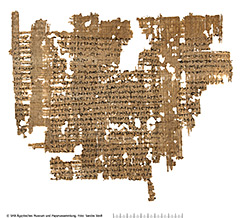BKT III, S. 22–26 (P. 9764)
How should a doctor and above all a surgeon be trained? This is the question which is being treated in this fragment of a papyrus scroll that contains an otherwise unknown treatise on the didactics of surgery. Only remnants of three columns have survived, of which, however, only the second column is well enough preserved that the content of the text can be deduced. The script can be dated to the end of the 1st century AD. The back contains only traces of a line written in a large, not decipherable hand. Whether and how these are related to the treatise on the front remains unclear.
The only well-preserved second column contains a discussion of the physician Archibius on questions concerning the education of physicians. About Archibius, his works and his teachings nothing is known except for this papyrus and a quote by the famous physician Galen, but he probably lived and worked at the beginning of the 1st century AD (or shortly before).
In the surviving remnants of his discussion, Archibius opposes the traditional doctrine of surgery. He criticizes a too early occupation with the theory. Surgical instruction begins with theoretical and historical discussion rather than direct practice. With reference to the first sentence of the first aphorism of Hippocrates („Life is short, art is long“ – later translated into Latin by Cicero: „Vita brevis, ars longa“) Archibius wishes instead a more practical education and especially an early start of surgical practice. He wishes that the diseases in need of surgical treatment are explained and the necessary skills practiced. In his opinion, it is absurd if the definitions of each disease are neglected and instead a definition of surgery, its origins, history and benefits are sought. Rather, it makes more sense if these questions are postponed and instead the doctrines of surgery are practically implemented and executed. Unfortunately, the end of this column is incomplete, so even these discussions remain fragmentary.
The views of the Archibius are quoted by the author of this text or referred to by their content. Unfortunately, too little of the text is preserved to answer the question definitely. Nor can it be determined whether he agreed with these views of Archibius or disapproved of them. In this respect, the character of this work of an unknown author can no longer be clearly determined. It may have been a biography of Archibius, in which his medical and didactic views are treated. More likely, however, we are dealing with a scientific work in which different views on the didactics of surgery or even medicine in general are discussed.
This fragment of a papyrus scroll thus provides insights into the medical teaching of antiquity. It is also a wonderful example of the significant expansion that our knowledge of the ancient medicine of the Greeks and Romans receives through the papyrus finds from the rubbish heaps of Greco-Roman Egypt. They are complemented by archaeological studies, which not only show us a lot about diseases in the ancient Mediterranean world, but also medical instruments that have been used to perform even sometimes complicated interventions.
This papyrus on the Didactics of Surgery was on display in the exhibition „Au temps de Galien. Un médicin grec dans l’empire romain“ at the Musée Royal de Mariemont in Morlanwelz in Belgium.



